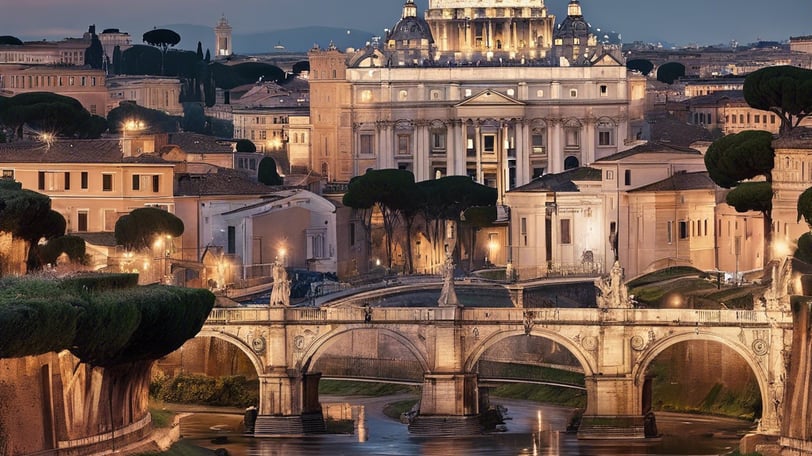Reasons To Plan a Trip To Rome
8/3/20248 min read


Introduction to Budget-Friendly Travel in Rome
Rome, the eternal city, captivates millions of visitors each year with its rich tapestry of history, culture, and cuisine. From the grandiosity of the Colosseum to the breathtaking beauty of the Sistine Chapel, Rome offers an experience unlike any other. However, the journey to this iconic destination can be daunting for those mindful of their budgets. This is where effective planning becomes crucial, ensuring you enjoy a fulfilling trip without financial strain.
Budget-friendly travel to Rome is not only possible but can also enhance the overall experience by uncovering hidden gems and local delights that are often overlooked in high-end itineraries. By focusing on cost-saving strategies, travelers can immerse themselves in Rome’s charm without feeling the pinch. Cheap travel to Rome doesn’t mean compromising on the richness of your experiences; rather, it involves making informed choices that stretch your budget further.
Whether you're a history buff, a culinary explorer, or a casual tourist, having a clear budget plan can make your Roman holiday both enjoyable and economical. The following sections will offer invaluable tips, from finding affordable accommodations to savoring budget-friendly meals and exploring the city without overspending. With the right guidance, saving money while relishing the sights and sounds of Rome becomes a seamless reality.
Finding Cheap Flights to Rome
Securing affordable flights to Rome is a crucial first step to managing your travel budget effectively. One of the best strategies for finding cheap flights is to book well in advance. Generally, booking your tickets around three to four months before your trip can offer significant savings. Utilizing price comparison websites like Skyscanner, Kayak, Expedia and Google Flights can help you identify the most cost-effective options by comparing various airlines and routes.
Another effective method is setting up fare alerts on these platforms. By doing so, you will receive notifications when prices drop for your specified routes. This proactive approach enables you to pounce on deals as soon as they become available, sometimes leading to substantial discounts.
Considering the timing of your flight can also make a considerable difference. Traveling during off-peak seasons, such as late autumn and early spring, often results in lower airfare. Additionally, flying mid-week rather than over the weekend can yield cheaper tickets, as airlines tend to reduce prices on less popular travel days. Flexible travel dates and times can further enhance your ability to snag the best deals.
Moreover, being flexible with your choice of departure and arrival airports can provide additional savings. For instance, if you live near multiple airports, checking fares from each can open up more economical options. Similarly, sometimes flying into or out of a nearby city and then taking a budget airline or other transportation to your final destination can be more economical.
Budget-Friendly Accommodation Options
When planning a trip to Rome, finding affordable accommodation is critical for budget-minded travelers. Luckily, there are several options available, ranging from hostels and budget hotels to vacation rentals. Each offers its own set of advantages and can help you save money while ensuring a comfortable stay.
Hostels are an excellent choice for solo travelers or groups looking to stretch their budget. They offer both dormitory-style and private rooms, providing flexibility based on your preference and budget. Many hostels in Rome are located in central areas, making it convenient to explore the city's major attractions without incurring additional transportation costs. Popular neighborhoods such as Trastevere and Monti are not only culturally rich but also home to several well-rated hostels.
Budget hotels provide another viable option. These establishments typically offer basic amenities, clean rooms, and in many cases, complimentary breakfasts. Booking a budget hotel in advance can lead to significant savings, as last-minute bookings often come with higher rates. Additionally, consider hotels slightly outside the main tourist hubs; areas such as San Giovanni and Testaccio offer both affordability and the charm of traditional Roman neighborhoods.
Vacation rentals, including apartments and homestays, offer a home-like experience and are ideal for longer stays or family trips. Platforms like Airbnb, Expedia and VRBO allow travelers to book entire apartments or rooms within a local's home, often at competitive prices. This type of accommodation provides the benefit of kitchen facilities, allowing you to prepare meals and save on dining costs. Additionally, staying in residential areas gives you a glimpse into local life and often provides quieter environments away from the tourist crowds.
Regardless of the type of accommodation you choose, reading reviews from previous guests can provide invaluable insights. Prioritize bookings that have consistently positive feedback regarding cleanliness, hospitality, and location. By carefully selecting your lodging and considering less touristy neighborhoods, you can achieve a balance between cost and convenience, enhancing your overall experience in Rome.
Eating Well on a Budget in Rome
When traveling to Rome, food is an integral part of the experience, and enjoying delicious, authentic cuisine doesn't have to break the bank. There are several ways to savor the culinary offerings of Rome while keeping your expenses under control. One of the most effective strategies is to seek out local markets and eateries that provide a genuine taste of Roman and Italian food at a fraction of the cost typically charged by touristy establishments.
Local markets like Campo de' Fiori or Mercato Testaccio are excellent starting points. Here, you can find fresh produce, artisanal cheeses, cured meats, and an array of other delectable items. Purchasing ingredients directly from these markets allows you to enjoy high-quality meals while supporting local vendors. Often, a simple picnic composed of market finds can be both satisfying and budget-friendly.
Additionally, avoiding tourist-heavy spots and opting for trattorias and pizzerias frequented by locals can significantly reduce food expenses. Trattorias, known for their homestyle cooking, and affordable pizzerias often provide hearty and authentic meals at reasonable prices. These establishments tend to offer daily specials, which are not only economical but also reflect the freshest ingredients of the day.
Another money-saving tip is to take advantage of the Italian tradition of aperitivo. During the aperitivo hours, usually between 6 PM and 8 PM, many bars offer a selection of free snacks with the purchase of a drink. This can range from simple olives and nuts to more substantial offerings like bruschetta, cheeses, and charcuterie. It’s an opportunity to enjoy a light meal while mingling with locals and soaking in the vibrant atmosphere.
Experiencing Rome’s culinary scene can be both enriching and economical. By dining at local markets, trattorias, and pizzerias, and leveraging aperitivo hours, you can indulge in the rich flavors of Roman cuisine without straining your travel budget. Focusing on these approaches ensures that your gastronomic journey through Rome is as enjoyable as it is affordable.
Exploring Rome on a budget can be both exciting and economical, with several transportation options that allow visitors to experience the city's rich history without breaking the bank. One of the most cost-effective choices is utilizing public transport. Rome boasts a comprehensive public transportation system, including buses and the metro, which can effortlessly connect you to all major attractions.
Buses and Metro
Rome's public buses are a convenient way to traverse the city. The extensive network covers virtually every corner, making it easy to reach destinations like the Colosseum, Vatican City, and Piazza Navona. Similarly, the metro system, though smaller, operates efficiently with two main lines intersecting at Termini Station, the city's central hub. A single ticket provides 100 minutes of travel, inclusive of transfers, and costs just €1.50. To maximize savings, consider purchasing a travel card or pass.
If you plan an extended stay, multi-day passes are beneficial. Options include the 24-hour pass at €7, 48-hour pass at €12.50, and 72-hour pass at €18, offering unlimited access to buses, trams, and metro trains within the validity period. Another valuable option is the Roma Pass, available in 48-hour (€32) or 72-hour (€52) versions. Besides free entry to one or two museums, the Roma Pass provides unlimited travel on public transport, making it an excellent all-inclusive choice for tourists.
Walking: An Economical and Immersive Experience
Walking is an incredibly cost-effective and immersive way to experience Rome. Many of the city's historic sites, such as the Roman Forum, the Pantheon, and Trevi Fountain, are within walking distance from each other. Strolling through charming neighborhoods like Trastevere or the bustling streets of Campo de' Fiori offers a unique perspective of the city. This method not only saves money but also allows for spontaneous exploration, uncovering hidden gems along the way.
By leveraging these economical transportation options, travelers can navigate Rome efficiently while keeping expenses in check. From the convenience of multi-day passes to the enriching experience of walking, these tips ensure a memorable and affordable visit to the Eternal City.
Vatican Museums, Sistine Chapel, and Basilica
Join a guided tour of the Vatican with fast-track access. Explore the Vatican Museums, the Sistine Chapel, and St. Peter's Basilica.
Colosseum and Roman Forum Experience
Immerse yourself in the world of ancient Rome with admission to the Colosseum, Forum, and Palatine Hill. Breeze past the ticket office lines and enhance your visit with an audio guide.
Amalfi Coast and Positano Day Trip with Coastal Cruise
Experience the towns of Positano and Amalfi on this day trip from Rome. Enjoy the sea views, explore local shops, and marvel at the stunning architecture of the Amalfi Coast's most delightful towns.
Get travel insurance
Travel insurance is essential for anyone planning a trip, as accidents can happen at any time. Having a good travel insurance policy could potentially save your life in unforeseen circumstances. Knowing that you have financial support in case of an emergency will give you peace of mind while traveling abroad. Whether it's a medical emergency, trip cancellation, or lost luggage, travel insurance can provide the necessary coverage and support to help you through difficult situations. It's always better to be safe than sorry, so make sure to invest in a comprehensive travel insurance plan before embarking on your next adventure.
What To Pack for Italy
Italy is a country known for its fashion and style, and what to wear can vary greatly depending on the season and temperature.
Temperature range between 60F to 75F.
In the summer, when temperatures can soar around 86F with high humidity, lightweight clothing such as sundresses, shorts, and t-shirts are popular choices. It's also important to bring a hat, sunglasses, and sunscreen to protect against the sun. In the cooler months, especially in the northern regions, layers are key.
A stylish coat, scarf, and comfortable boots are essential for staying warm while still looking fashionable. Regardless of the season, it's always a good idea to pack comfortable walking shoes, as exploring Italy often involves a lot of walking. It's also important to remember that in more conservative areas, such as churches and religious sites, it's respectful to dress modestly, covering shoulders and knees. By keeping these tips in mind, you'll be ready to dress appropriately for any season and temperature in Italy.
































Explore
Discover amazing budget-friendly travel destinations for you!
© 2024. All rights reserved.
